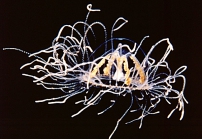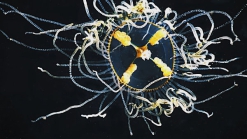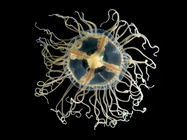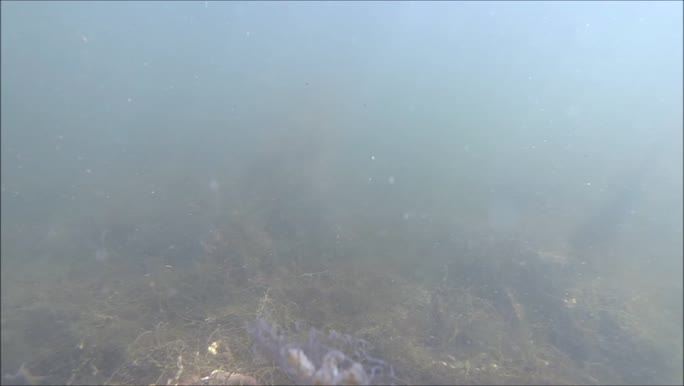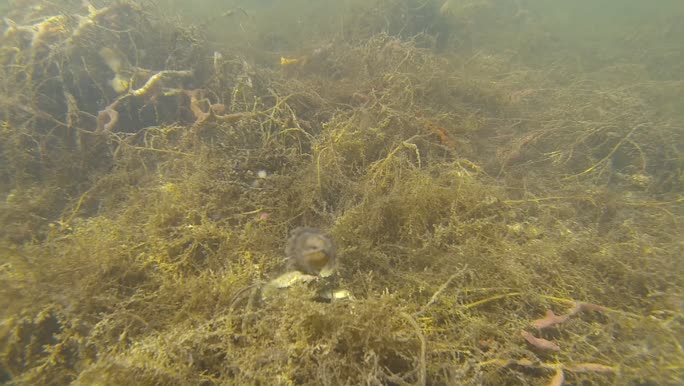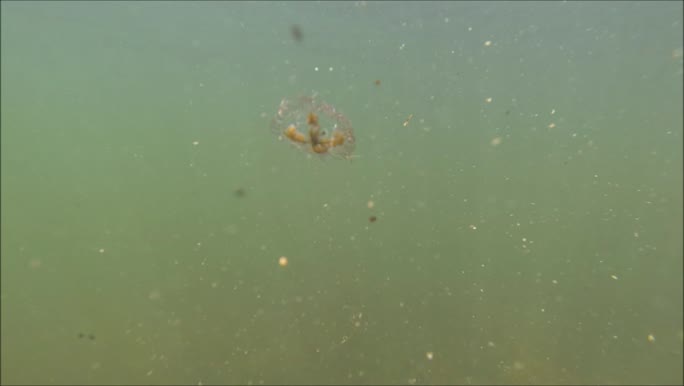
| Intro | | Search taxa | | Browse taxa | | Distributions | | Terminology | | References | | Statistics | | Online sources | | Tutorial | | Log in |
WRiMS taxon detailsGonionemus vertens A. Agassiz, 1862
117768 (urn:lsid:marinespecies.org:taxname:117768)
accepted
Species
marine,
recent only
Agassiz, L. (1862). Contributions to the natural history of the United States of America. <em>Little Brown, Boston.</em> 4: 1-380, pls 1-19., available online at https://www.biodiversitylibrary.org/page/16068829
page(s): 350 [details]
Schuchert, P. (2024). World Hydrozoa Database. Gonionemus vertens A. Agassiz, 1862. Accessed through: Costello, M. J.; Ahyong, S.; Bieler, R.; Boudouresque, C.; Desiderato, A.; Downey, R.; Galil, B. S.; Gollasch, S.; Hutchings, P.; Kamburska, L.; Katsanevakis, S.; Kupriyanova, E.; Lejeusne, C.; Ma, K. C. K.; Marchini, A.; Occhipinti, A.; Pagad, S.; Panov, V. E.; Poore, G. C. B.; Rewicz, T.; Robinson, T. B.; Rius, M.; Sobczyk, R.; Stern, N.; Turon, X.; Valls Domedel, G.; Verleye, T.; Vieira, L. M.; Willan, R. C.; Yeo Chong Jinn, D.; Zhan, A. (2024) World Register of Introduced Marine Species (WRiMS) at: https://www.marinespecies.org/introduced/aphia.php?p=taxdetails&id=117768 on 2024-04-23
Costello, M. J.; Ahyong, S.; Bieler, R.; Boudouresque, C.; Desiderato, A.; Downey, R.; Galil, B. S.; Gollasch, S.; Hutchings, P.; Kamburska, L.; Katsanevakis, S.; Kupriyanova, E.; Lejeusne, C.; Ma, K. C. K.; Marchini, A.; Occhipinti, A.; Pagad, S.; Panov, V. E.; Poore, G. C. B.; Rewicz, T.; Robinson, T. B.; Rius, M.; Sobczyk, R.; Stern, N.; Turon, X.; Valls Domedel, G.; Verleye, T.; Vieira, L. M.; Willan, R. C.; Yeo Chong Jinn, D.; Zhan, A. (2024). World Register of Introduced Marine Species (WRiMS). Gonionemus vertens A. Agassiz, 1862. Accessed at: https://marinespecies.org/introduced/aphia.php?p=taxdetails&id=117768 on 2024-04-23
Date action by
original description
Agassiz, L. (1862). Contributions to the natural history of the United States of America. <em>Little Brown, Boston.</em> 4: 1-380, pls 1-19., available online at https://www.biodiversitylibrary.org/page/16068829
page(s): 350 [details] context source (Introduced species) Katsanevakis, S.; Bogucarskis, K.; Gatto, F.; Vandekerkhove, J.; Deriu, I.; Cardoso A.S. (2012). Building the European Alien Species Information Network (EASIN): a novel approach for the exploration of distributed alien species data. <em>BioInvasions Records.</em> 1: 235-245., available online at http://easin.jrc.ec.europa.eu [details] Available for editors context source (Hexacorallia) Fautin, Daphne G. (2013). Hexacorallians of the World. (look up in IMIS) [details] basis of record van der Land, J.; Vervoort, W.; Cairns, S.D.; Schuchert, P. (2001). Hydrozoa, <B><I>in</I></B>: Costello, M.J. <i>et al.</i> (Ed.) (2001). <i>European register of marine species: a check-list of the marine species in Europe and a bibliography of guides to their identification. Collection Patrimoines Naturels,</i> 50: pp. 112-120 (look up in IMIS) [details] additional source Meinkoth, N. A. (1981). Field guide to North American seashore creatures. <em>The Audubon Society.</em> 1-799. [details] additional source Pollock, L.W. (1998). A practical guide to the marine animals of northeastern North America. Rutgers University Press. New Brunswick, New Jersey & London. 367 pp., available online at http://books.google.com/books?id=i1AmT31cuR4C [details] additional source Muller, Y. (2004). Faune et flore du littoral du Nord, du Pas-de-Calais et de la Belgique: inventaire. [Coastal fauna and flora of the Nord, Pas-de-Calais and Belgium: inventory]. <em>Commission Régionale de Biologie Région Nord Pas-de-Calais: France.</em> 307 pp., available online at http://www.vliz.be/imisdocs/publications/145561.pdf [details] additional source Streftaris, N., A. Zenetos & E. Papathanassiou. (2005). Globalisation in marine ecosystems: the story of non-indigenous marine species across European seas. <em>Oceanogry and Marine Biology: an Annual Review.</em> 43: 419-453. (look up in IMIS) [details] Available for editors additional source Uchida, T., 1976. A new sporozoan-like reproduction in the Hydromedusa, Gonionemus vertens. Proc. Jap. Acad. Sci. 52 7: 387-388. [details] additional source Integrated Taxonomic Information System (ITIS). , available online at http://www.itis.gov [details] additional source Bouillon, J.; Boero, F. (2000). Synopsis of the families and genera of the Hydromedusae of the world, with a list of the worldwide species. <i>Thalassia Salent. 24</i>: 47-296 (look up in IMIS) [details] additional source Zenetos, A.; Çinar, M.E.; Pancucci-Papadopoulou, M.A.; Harmelin, J.-G.; Furnari, G.; Andaloro, F.; Bellou, N.; Streftaris, N.; Zibrowius, H. (2005). Annotated list of marine alien species in the Mediterranean with records of the worst invasive species. <em>Mediterranean Marine Science.</em> 6 (2): 63-118., available online at https://www.researchgate.net/publication/273213810_Annotated_list_of_marine_alien_species_in_the_Mediterranean_with_records_of_the_worst_invasive_species [details] Available for editors additional source Occhipinti-Ambrogi, A., A. Marchini, G. Cantone, A. Castelli, C. Chimenz, M. Cormaci, C. Froglia, G. Furnari, M.C. Gambi, G. Giaccone, A. Giangrande, C. Gravil, F. Mastrototaro, C. Mazziotti, L. Orsi-Relini & S. Piraino. (2010). Alien species along the Italian coasts: an overview. <em>Biological Invasions.</em> 13(1): 215-237., available online at https://doi.org/10.1007/s10530-010-9803-y [details] Available for editors additional source Liu, J.Y. [Ruiyu] (ed.). (2008). Checklist of marine biota of China seas. <em>China Science Press.</em> 1267 pp. (look up in IMIS) [details] Available for editors additional source Zenetos, A.; Gofas, S.; Verlaque, M.; Cinar, M.; Garcia Raso, J.; Bianchi, C.; Morri, C.; Azzurro, E.; Bilecenoglu, M.; Froglia, C.; Siokou, I.; Violanti, D.; Sfriso, A.; San Martin, G.; Giangrande, A.; Katagan, T.; Ballesteros, E.; Ramos-Espla, A.; Mastrototaro, F.; Ocana, O.; Zingone, A.; Gambi, M.; Streftaris, N. (2010). Alien species in the Mediterranean Sea by 2010. A contribution to the application of European Union's Marine Strategy Framework Directive (MSFD). Part I. Spatial distribution. <em>Mediterranean Marine Science.</em> 11(2): 381-493., available online at https://doi.org/10.12681/mms.87 [details] additional source Bakker, C. (1980) On the distribution of Gonionemus vertens A. Agassiz (Hydrozoa, Limnomedusae), a new species in the eelgrass beds of Lake Grevelingen (S. W. Netherlands),Hydrobiological Bulletin 14: 186-195 [details] additional source Eno, N. C.; Clark, R. A.; Sanderson, W. G. (1997). Non-native marine species in British waters: a review and directory. <em>Joint Nature Conservation Committee, Peterborough.</em> pp. 136. (look up in IMIS) [details] Available for editors additional source Trott, T. J. (2004). Cobscook Bay inventory: a historical checklist of marine invertebrates spanning 162 years. <em>Northeastern Naturalist.</em> 11, 261-324., available online at http://www.gulfofmaine.org/kb/files/9793/TROTT-Cobscook%20List.pdf [details] Available for editors status source Govindarajan, A. F.; Carman, M. R.; Khaidarov, M. R.; Semenchenko, A.; Wares, J. P. (2017). Mitochondrial diversity in Gonionemus (Trachylina:Hydrozoa) and its implications for understanding the origins of clinging jellyfish in the Northwest Atlantic Ocean. <em>PeerJ.</em> 5: e3205., available online at https://doi.org/10.7717/peerj.3205 note: study of different strains and subspecies, stinging form [details] status source Govindarajan, A.F., B. Källström, E. Selander, C. Östman & T.G. Dahlgren. (2019). The highly toxic and cryptogenic clinging jellyfish Gonionemus sp. (Hydrozoa, Limnomedusae) on the Swedish west coast. <em>PeerJ.</em> 7: 1-13. e6883., available online at https://doi.org/10.7717/peerj.6883 [details] Available for editors  Present Present  Inaccurate Inaccurate  Introduced: alien Introduced: alien  Containing type locality Containing type locality
From regional or thematic species database
Introduced species abundance in Baltic Sea (IHO Sea Area) : not established at this location [details]Introduced species abundance in United Kingdom part of the English Channel (Marine Region) : Common [details] Introduced species abundance in United Kingdom part of the North Sea (Marine Region) : Common [details] Introduced species abundance in Portugal (Nation) : Common [details] Introduced species population trend in United States Exclusive Economic Zone (EEZ) : Edwards (1976) considered it extinct on the East Coast, but Gosner (1978) noted it as 'erratic' since the 1930s. [details] Introduced species remark United States part of the North Atlantic Ocean (Marine Region) We describe a possible cryptic invasion of the toxic Western Pacific hydromedusa Gonionemus vertens (Cnidaria, Hydrozoa, Limnomedusae) in the Northwest Atlantic Ocean. G. vertens was first noticed in Eel Pond in Woods Hole (Cape Cod), Massachusetts in 1894, but nearly disappeared in the 1930s, coincident with a large scale die-off of its preferred eelgrass habitat. During the 1894–1930 period, G. vertens was the object of numerous studies by local scientists, and was not reported as stinging. In contrast, Western Pacific G. vertens are known for their toxic sting symptoms, which include severe pain, respiratory distress, and paralysis. Here, we report new sightings in the northwest Atlantic from the late twentieth century onwards. Sightings are most frequent in Waquoit Bay on the southern-facing shore of Cape Cod, Massachusetts, and on the island of Martha’s Vineyard, Massachusetts, but medusae have also been found in locations ranging from Long Island (New York) to Wellfleet Harbor on the north side of Cape Cod. [details] Introduced species vector dispersal Argentinean part of the South Atlantic Ocean (Marine Region) Ships: accidental with ballast water, sea water systems, live wells or other deck basins [details] Introduced species vector dispersal in Belgian part of the North Sea: Aquaculture: accidental [details] Introduced species vector dispersal Argentinean part of the South Atlantic Ocean (Marine Region) Ships: accidental as attached or free-living fouling organisms [details] Introduced species vector dispersal in Baltic Sea (IHO Sea Area) : Fisheries: accidental with deliberate translocations of fish or shellfish Edwards (1976) considered oyster culture, particularly the 'Portuguese' oyster (C. angulata), introduced from Asia in the 16th-17th century, to be the likeliest vector for the introduction of this hydrozoan to Europe. [details] Introduced species vector dispersal in French part of the English Channel (Marine Region) : Fisheries: accidental with deliberate translocations of fish or shellfish Edwards (1976) considered oyster culture, particularly the 'Portuguese' oyster (C. angulata), introduced from Asia in the 16th-17th century, to be the likeliest vector for the introduction of this hydrozoan to Europe. [details] Introduced species vector dispersal in Norwegian part of the Skagerrak (Marine Region) : Fisheries: accidental with deliberate translocations of fish or shellfish Edwards (1976) considered oyster culture, particularly the 'Portuguese' oyster (C. angulata), introduced from Asia in the 16th-17th century, to be the likeliest vector for the introduction of this hydrozoan to Europe. [details] Introduced species vector dispersal in United States Exclusive Economic Zone (EEZ) : Fisheries: accidental with deliberate translocations of fish or shellfish Edwards (1976) suggests that a possible vector for this hydrozoan was shellfish research by the US Fisheries Commission, which included rearing and stocking of Pacific Clams (Protothaca staminea), or more likely, oysters from Europe, possibly including the 'Portuguese' Oyster (Crassostrea angulata), with which the polyp could have been carried from Asia. Ballast water or hull fouling is less likely, as they could not account for the highly localized distribution on the East Coast. [details] Introduced species vector dispersal in United Kingdom part of the English Channel (Marine Region) : Fisheries: accidental with deliberate translocations of fish or shellfish [details] Introduced species vector dispersal in United Kingdom part of the North Sea (Marine Region) : Ships: general [details] Introduced species vector dispersal in United Kingdom part of the North Sea (Marine Region) : Fisheries: accidental with deliberate translocations of fish or shellfish [details] Introduced species vector dispersal in Belgian part of the North Sea: Ships: accidental as attached or free-living fouling organisms [details] Introduced species vector dispersal in Belgian part of the North Sea: Ships: accidental with ballast water, sea water systems, live wells or other deck basins [details] Introduced species vector dispersal United States part of the North Pacific Ocean (Marine Region) Debris: transport of species on human generated debris (dock) [details] Introduced species vector dispersal in Portugal (Nation) : Shipping [details]
To Barcode of Life (15 barcodes)
To Biodiversity Heritage Library (69 publications) To Biological Information System for Marine Life (BISMaL) To European Nucleotide Archive (ENA) To GenBank (9 nucleotides; 3 proteins) To Information system on Aquatic Non-Indigenous and Cryptogenic Species (AquaNIS) To PESI To USNM Invertebrate Zoology Cnidaria Collection (27 records) To ITIS |
